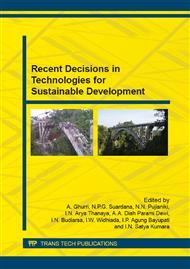p.3
p.9
p.17
p.24
p.30
p.36
p.41
p.47
p.53
The Structural Properties Assessment of Thin Hot Mixture Asphalt for Pavement Preservation
Abstract:
Thin Hot Mixture Asphalt Concrete Overlays (THMACO’s) are comprised of a thin layer less than one inch hot mix asphalt concrete layer and a binder material/tack coat. The uses of thin layer are necessary to compromise with the environment issue especially to protect the natural resources and save the energy used during asphalt construction. THMACO’s can be used as preventative maintenance on pavement preservation or as a new surface on a pavementconstruction. This layeris usually regarded as non-structural layer at pavement design. However, this paper presents the structural assessment of this materials and their comparison to the conventional asphalt concrete mixtures. This research was conducted based on indirect tensile strength (ITS), unconfined compressive strength (UCS) and indirect tensile stiffness modulus (ITSM) of thin hot mixture asphalt. The results show that the thin hot mixture asphalt has performed slightly different on the Marshall and structural properties compare to conventional asphalt concrete.
Info:
Periodical:
Pages:
30-35
Citation:
Online since:
July 2015
Authors:
Price:
Сopyright:
© 2015 Trans Tech Publications Ltd. All Rights Reserved
Share:
Citation:


